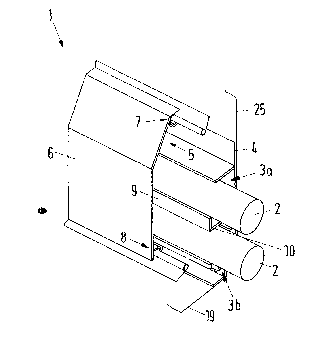Une partie des informations de ce site Web a été fournie par des sources externes. Le gouvernement du Canada n'assume aucune responsabilité concernant la précision, l'actualité ou la fiabilité des informations fournies par les sources externes. Les utilisateurs qui désirent employer cette information devraient consulter directement la source des informations. Le contenu fourni par les sources externes n'est pas assujetti aux exigences sur les langues officielles, la protection des renseignements personnels et l'accessibilité.
L'apparition de différences dans le texte et l'image des Revendications et de l'Abrégé dépend du moment auquel le document est publié. Les textes des Revendications et de l'Abrégé sont affichés :
| (12) Demande de brevet: | (11) CA 2062868 |
|---|---|
| (54) Titre français: | CANALISATION POUR RESEAUX D'UTILITE PUBLIQUE |
| (54) Titre anglais: | INSTALLATION DUCT FOR UTILITY LINES |
| Statut: | Réputée abandonnée et au-delà du délai pour le rétablissement - en attente de la réponse à l’avis de communication rejetée |
| (51) Classification internationale des brevets (CIB): |
|
|---|---|
| (72) Inventeurs : |
|
| (73) Titulaires : |
|
| (71) Demandeurs : |
|
| (74) Agent: | MARKS & CLERK |
| (74) Co-agent: | |
| (45) Délivré: | |
| (22) Date de dépôt: | 1992-03-12 |
| (41) Mise à la disponibilité du public: | 1992-09-19 |
| Licence disponible: | S.O. |
| Cédé au domaine public: | S.O. |
| (25) Langue des documents déposés: | Anglais |
| Traité de coopération en matière de brevets (PCT): | Non |
|---|
| (30) Données de priorité de la demande: | ||||||
|---|---|---|---|---|---|---|
|
ABSTRACT OF THE DISCLOSURE
An installation duct for utility lines, particularly for
pipes, cables, etc. , which, together with a retaining strip on
the side of the duct facing the wall, as well as a capping that
can be attached thereto, forms a cable or pipe duct that is
closed off at the periphery, upper and lower connectors being
provided for connecting the retaining strip and the capping.
One connector is constructed as a catch and the other as a lock,
which comprises an abutment at the retaining strip and a latch
clasp which can be secured behind this abutment at the capping.
In order to provide a cable or pipe duct, which can be installed
with little effort, the retaining strip has at its front side
integrally molded supporting walls which, together with edge plates,
form gutter-shaped ducts of different dimensions for different
types of utility lines, at lease one edge plate being constructed
at its outer side as a seat for the capping and the connectors
of the capping specifying a connecting position in which the cap-
ping rests against the seat.
Note : Les revendications sont présentées dans la langue officielle dans laquelle elles ont été soumises.
Note : Les descriptions sont présentées dans la langue officielle dans laquelle elles ont été soumises.

2024-08-01 : Dans le cadre de la transition vers les Brevets de nouvelle génération (BNG), la base de données sur les brevets canadiens (BDBC) contient désormais un Historique d'événement plus détaillé, qui reproduit le Journal des événements de notre nouvelle solution interne.
Veuillez noter que les événements débutant par « Inactive : » se réfèrent à des événements qui ne sont plus utilisés dans notre nouvelle solution interne.
Pour une meilleure compréhension de l'état de la demande ou brevet qui figure sur cette page, la rubrique Mise en garde , et les descriptions de Brevet , Historique d'événement , Taxes périodiques et Historique des paiements devraient être consultées.
| Description | Date |
|---|---|
| Inactive : CIB de MCD | 2006-03-11 |
| Inactive : CIB de MCD | 2006-03-11 |
| Inactive : CIB de MCD | 2006-03-11 |
| Inactive : CIB de MCD | 2006-03-11 |
| Inactive : CIB de MCD | 2006-03-11 |
| Le délai pour l'annulation est expiré | 1998-03-12 |
| Demande non rétablie avant l'échéance | 1998-03-12 |
| Réputée abandonnée - omission de répondre à un avis sur les taxes pour le maintien en état | 1997-03-12 |
| Demande publiée (accessible au public) | 1992-09-19 |
| Date d'abandonnement | Raison | Date de rétablissement |
|---|---|---|
| 1997-03-12 |
Les titulaires actuels et antérieures au dossier sont affichés en ordre alphabétique.
| Titulaires actuels au dossier |
|---|
| HEWING GMBH |
| Titulaires antérieures au dossier |
|---|
| JORG HANSEN |